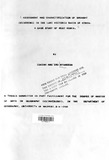| dc.contributor.author | Nyandega, Isaiah A | |
| dc.date.accessioned | 2013-05-29T13:30:17Z | |
| dc.date.available | 2013-05-29T13:30:17Z | |
| dc.date.issued | 1990 | |
| dc.identifier.citation | Master of Arts in Geography (Climatology), University of Nairobi, 1990 | en |
| dc.identifier.uri | http://erepository.uonbi.ac.ke:8080/xmlui/handle/123456789/27076 | |
| dc.description.abstract | The droughts of early 1970s and early 1980s were some of the
worst on record in the history of Sub-Saharan Africa.drought
which in this study refers to an extended period of exceptional low
rainfall, has been associated with negative effects in Africa with
the drought of early 1970s and early 1980s be inc some of the worst
especially in the Sahel region. The effects of these droughts of
the 1970s and the 1980s led to increased attention on the climatic
anomalies in Africa especially drought in the Sahel. The increased
attention had hitherto largely ignored the high rainfall areas of
Africa in terms of drought; occurrence and yet these areas are the
granaries of the Continent,s populace.
This study was aimed at finding out whether the high potential
lands of Kenya are prone to drought occurrence (especially
meteorological drought) . The study also was aimed at finding out,
if the above was true, whether there are unique characteristics of
drought occurrence in the high potential lands of Kenya that can
be used as a basis for better informed resource o 1ann it)Q. Lake
Victoria Basin which has the largest share of the high potential
lands in Kenya was selected as the main area to be covered by the
study. The Nyanza and Western Provinces (WEST KENYA) were used as
representatives of the Lake Victoria Basin of Kenya and this was
because nearly all the agro-climatic zones of the Basin are found
there.
Dai1y rainfall totals data from twelve Rainfall Recording
Stations as were available at the Meteorological Headquarters.
Nairobi. were used for the study. In addition. data on the daily
river flows for Nzoia. Yala. Nyando. Sondu-Miriu. and Gucha-Migori
were also used as supporting information as were the agricultural
reports for West Kenya. The daily rainfall data used were for the
period 1971-80 and were those of the months of January to July.
The main statistical analysis technique used in the study was
the Time-Series Analysis which allows a temporal presentation of
the data. This technique therefore suited the need in the study to
identify periods of abnormal low rainfall that could be described
as meteorological drought conditions. Of the various Time-Series
Analysis techniques. the study used the Series Plot. the Weighted
(Binomial weights) Running Mean.the Auto correlation Test. and the
Correlogram Test. The study first subjected the data distributions
to basic statistical analysis using the Mean. Median. Mode.
Kurtosis .Skewness .Frequency Tabulation. and the Analysis of
Variance Test (ANOVA) so as to reveal the central or general
tendencies in the data. In the study. the hypothesis investigated
was that • the drought.s of the earl y 1970s and the earl 1980s
never occurred in West Kenya and the food short.age experienced
during the periods could not have been as a result of rainfall
failure. Statistical significance tests were in all cases done at
alpha 0.05 level.
It was found that the droughts of early 1970s and early 1980s
could be traced in the day 1v rainfall series for the months of
January to Jul y between 1971 and 1985 as was characterized by
depressed rainfall distributions «5rMA per day) or breaks in the
rainfall series «0.25mtf' per day). The depressions «5mm per day)
or breaks «0.25mm per day) were not well defined in the rainfall
series distributions and this indicated more of erratic or delayed
or early ending distribution of rains than well defined
meteorological drought situations. The "drought conditions" traced
in the rainfall distributions between 1971 and 1985 occurred in mid
1970s and in the 1970s-1980s transition period especially 1979-1981
period. Food shortage , therefore,which were experienced outside
the periods above could not have been due to nature
anomalies(rainfall failure) only.
On the basis of the findings.it was real issued that a detailed
characterization of drought occurrence in the Lake Victoria Basin
of Kenya was still limited unless the daily water balance
conditions in the Basin were availed. Nevertheless. it was
concluded that as economic practices in West Kenya should have inbuilt
"drought shock-absorbers" like food buffer stocks.
of time tested drought resistant crops .and other forms of
production and drought management strategies. This was because the
possibility of rains not meeting the crop requirements was found
to be very real in West Kenya. The study faced the problem of poor
data entry and erroneous recording and it is therefore recommended
that data recording. entry and Meteorological Stations or recording
stations) should be managed by trained and interested personnel. | en |
| dc.language.iso | en | en |
| dc.publisher | University of Nairobi | en |
| dc.title | Assessment and characterization of drought occurrence in the Lake Victoria basin of Kenya: a case study of West Kenya | en |
| dc.type | Thesis | en |
| local.publisher | Department of Geography, university of Nairobi | en |

